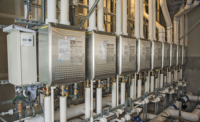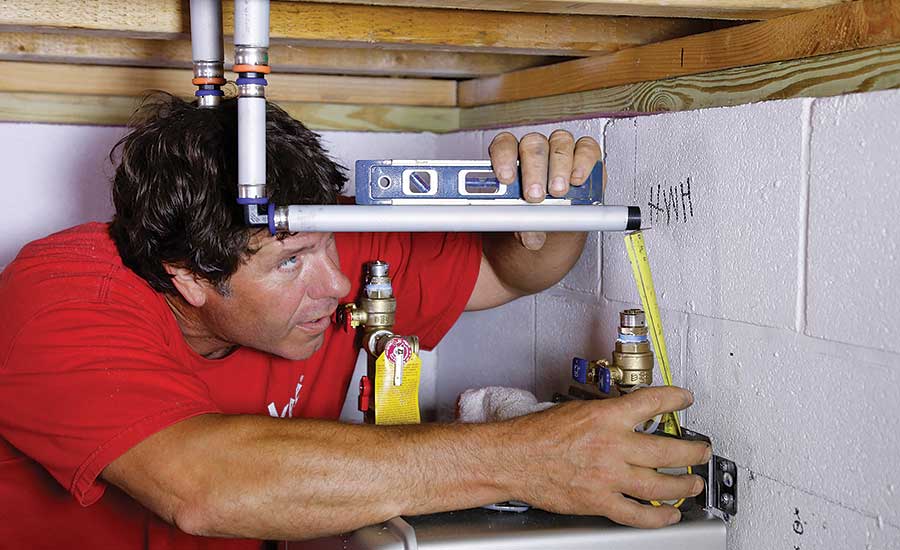How to install a tankless water heater
Follow these guidelines to make installing a tankless water heater as simple as possible.

The type of tankless water heater chosen for any given application will depend on incoming water temperatures and building use patterns. Photo credit: Christopher Beauchamp/Noritz

Tankless water heaters can save users up to 40% on energy costs when compared with storage-tank options if properly installed. Photo credit: Christopher Beauchamp/Noritz


Long recognized in Europe and Asia as a major energy- and space-saving solution, tankless water heaters have begun to make significant inroads in the North American market. By 2024, North America is expected to command more than 45% of the global tankless water heater market, according to Goldstein Research.
As more and more plumbers begin to install this technology, which can save their customers up to 40% on energy costs when compared with storage-tank options, the need for proper installation guidelines will become greater than ever. Installers accustomed to tank-only installs will need to understand the following aspects of tankless water heater installations.
Unit Selection
The type of tankless water heater chosen for any given application will depend on incoming water temperatures and building use patterns.
The first step is to determine the temperature rise — the desired hot-water temperature minus the incoming groundwater temperature, or the Delta T. This calculation will indicate how hard the water heater must work to provide hot water for the application.
Incoming groundwater temperature can be measured directly or estimated by a knowledgeable professional. It should be noted that, for sizing purposes, the typical worst-case scenario (the middle of winter) should be assumed for the incoming groundwater temperature to ensure adequate hot-water availability year-round.
Next, identify the peak hot-water flow. Tankless water heaters differ from tank-type models in their ability to provide continuous hot water — there’s no storage to run out of. To maintain the proper flow to meet the simultaneous needs of the entire building, it’s important to calculate the amount of hot water typically used at any given time:
- Count the quantity of fixtures of each type — i.e. dishwasher, shower heads, etc.
- Multiply this number by the flow rate of each particular fixture type. Table 1 displays a list of common fixtures and their approximate flow rates.
- Finally, calculate the sum of all these flow rates, as if all the appliances were operating simultaneously. The tankless water heater must be able to deliver this maximum flow rate at the desired temperature rise.
For example, suppose a building has three fixtures: the shower has a flow rate of 2.5 gpm, the washing machine has a flow rate of 2 gpm, and the hand-washing sink has a flow rate of 0.75 gpm. Add those flow rates together to get 5.25 gpm — that is the total demand to be met. (See Table 1 for additional flow rate averages.)
TABLE 1 — FIXTURE FLOW RATES
| Tub | 4.0 gpm | ||
| Shower | 2.5 gpm | ||
| Washing Machine | 2.0 gpm | ||
| Dishwasher | 1.5 gpm | ||
| Kitchen Sink | 1.5 gpm |
Gas Supply
Typically, tankless water heaters will use higher gas quantities than their tank counterparts to meet the sudden demand for hot water without storage. The installer must ensure that the building has sufficient gas pressure to allow for the unit to meet all the building’s gas needs. If in doubt, contact the gas utility to verify proper gas meter size.
Once the gas meter’s capacity is confirmed, determine whether the gas line is also adequately sized to supply enough gas to the water heater. A typical tankless water heater will need a ¾-inch gas line. However, if there is sufficient pressure and the run length is short enough, it is possible to use a ½-inch line, which is used by most existing storage tank-type water heaters.
Being able to reuse the existing gas line allows for a faster, less costly installation when replacing a tank unit with a tankless model. But be sure to account for all the appliances using this line, not just the water heater. Installers should verify with their local gas company the line size and licensing rules and codes.
Air Requirements
Like any water heater, a tankless unit needs a sufficient amount of incoming air for the combustion process to operate properly. Many units are vented directly, taking combustion from the outdoors. Others can be installed outside, depending on climate. Both situations presume combustion air is not a concern for installation. In fact, if combustion air is a difficulty, direct or outdoor venting should be considered.
The size of the openings for combustion air — from indoors or outdoors — is based upon the tankless unit’s Btu input.
- If the heater draws combustion air from the surrounding indoors, 1 square inch of combustion-air opening is needed per every 1,000 Btu/h of the appliance.
- If the heater draws air from the outside, the openings required are at a rate of 1 square inch per 4,000 Btu/h.
Examples: For a 199,000 Btu/h tankless water heater, openings at a minimum 199 square inches (199,000/1,000) would be needed for indoor air. For outdoor air, 50 square inches (199,000/4,000) of opening would be needed.
Temperature Settings
For residential applications, the hot water set point temperature should be only slightly above the highest temperature needed for domestic uses. Typically, shower temperatures are 104°-106° F. Consequently, a tankless water heater should rarely be set above 115°-120°. The nationally recognized temperature for when scalding is significantly more likely to occur is 125° F, so it is generally not recommended to set the water heater higher than this.
Unlike a storage tank-type water heater, which can be susceptible to Legionnaires’ disease bacteria growth, tankless water heaters do not store any hot water. In fact, they continuously flush any internal water with every use. As a result, there is no sanitary reason to maintain a high set point temperature; the only rationale is user comfort.
Water Quality
Water quality is an important consideration for all water equipment, and water heaters will often be impacted the most. Of particular note is water hardness, which is a measure of the minerals (magnesium and calcium) it contains.
When heated, these minerals tend to precipitate out and form crystals, called lime scale, which can coat pipes. The lime scale acts as an insulator, reducing heat-transfer efficiency (the fraction of heat energy that moves from the burner to the water) and increasing thermal stress, which can ultimately reduce the water heater’s lifespan.
Steps can be taken to remove lime scale on a regular basis through a process called descaling, in which vinegar is flushed through the water heater’s heat exchanger coils to remove the buildup. Ultimately, it’s important to know the local water quality and take steps to either treat the water or establish a maintenance plan.
Condensation
There are special considerations when installing high-efficiency condensing tankless water heaters, which capture and reuse latent heat from the combustion process. A byproduct of this process is an acidic condensate that must be handled appropriately before the water moves to the drainage system. Check local building codes for safe disposal procedures — a neutralizer may be required to protect the plumbing.
Heeding these considerations will help make installing a tankless water heater for a client as simple as possible. A properly sized unit with sufficient air and gas inputs will provide efficient, on-demand hot water for your customers, leading to increased comfort and long-term savings.
Looking for a reprint of this article?
From high-res PDFs to custom plaques, order your copy today!








